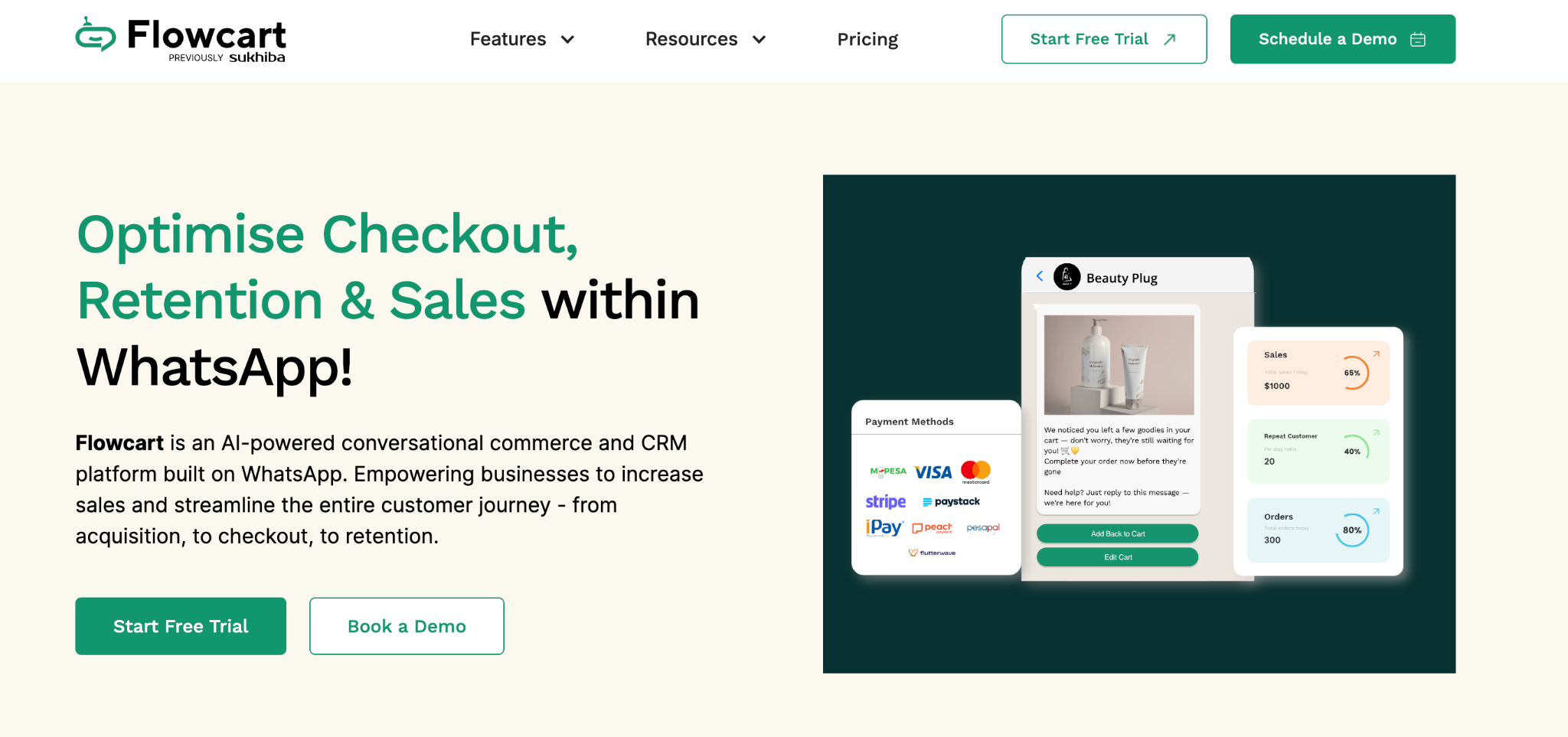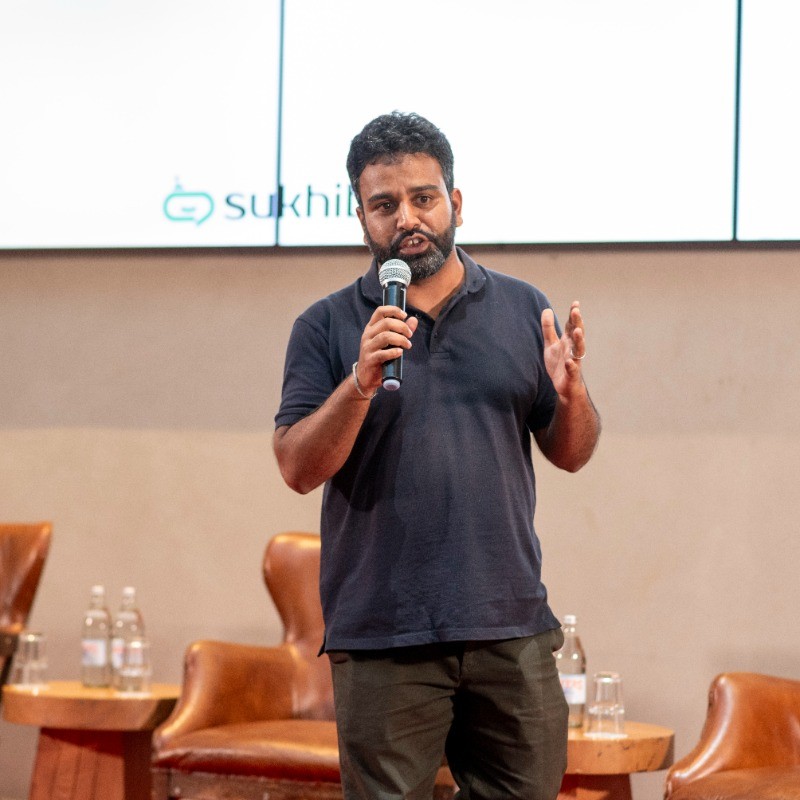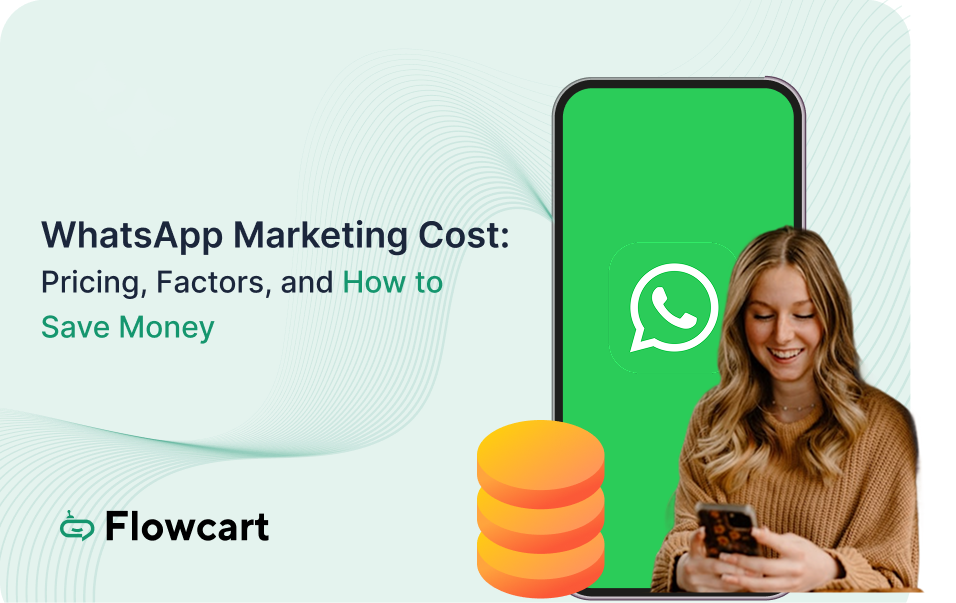Key Takeaways
- WhatsApp marketing costs depend on message type, country, and vendor fees. Pay attention to how many messages you send and who gets them.
- Smart segmentation, automation, and keeping campaigns relevant can save you money and boost your ROI.
- Flowcart makes cost tracking easier with analytics and flexible pricing, so you only spend where it actually works.
Alan received two sale alerts last week: one by email and one on WhatsApp. The email, announcing a “20% off electronics” deal, got lost under a pile of other brand offers. But the WhatsApp message was different. It highlighted a limited-time discount on noise-cancelling headphones. Alan noticed it while chatting with his friends, opened it instantly, and placed the order that very evening.
This one instance showcases that emails no longer deliver the ROI they once did, while WhatsApp has become the go-to channel for real engagement, offering clear marketing benefits. In fact, over 50 million companies worldwide already use WhatsApp to reach customers.
That said, between Meta’s per-message fees, vendor charges, and campaign costs, WhatsApp marketing cost can be confusing.This often leads to two extremes: some businesses stay away altogether and miss out on massive ROI, while others jump in but overspend without a strategy to control costs.
But WhatsApp marketing doesn’t have to be expensive when you understand the pricing structure and know how to optimize campaigns. This guide breaks down WhatsApp marketing costs in 2025, explains factors that influence pricing, and shares smart WhatsApp marketing strategies to save money.
Understanding WhatsApp Marketing Costs
WhatsApp marketing costs are influenced by three primary factors: the platform you use, the type of conversations you conduct, and the vendor you partner with. Let us break down each of these factors to decode WhatsApp pricing:
WhatsApp Business App vs WhatsApp Business API
Businesses can choose from two options for their WhatsApp marketing campaigns:
- WhatsApp Business App: The WhatsApp business app variant is designed with small-scale businesses in mind, enabling them to connect with customers and showcase their products. The best part is it's entirely free to use. You do not have to pay any fee for sending marketing campaigns to your customers, nor do you have to pay any subscription fee.
- WhatsApp Business API: This WhatsApp variant is for businesses with a larger customer base and more intricate personalization and automation requirements. It follows a per-message pricing model based on the type of conversation.
For small businesses, it’s best to start with the free WhatsApp Business App to keep costs low. They can later upgrade to the WhatsApp Business API as the customer base grows or when advanced personalization and WhatsApp marketing automation are needed to optimize campaigns.
Message-Based Pricing Model
While earlier WhatsApp followed a conversation-based pricing model, WhatsApp API now follows a per-message pricing model starting July 1, 2025. The cost per message varies depending on the type of conversation that is initiated. Here are the four categories:
Marketing: Messages initiated to drive sales, such as promotions, offers, or product recommendations.
Example: “Get 20% off your next order! Shop now before the sale ends.”
Utility: Non-promotional messages, initiated for smooth functioning or providing updates to the user, such as order confirmations, payment alerts, or delivery notifications.
Example: “Your order #1234 has been shipped and will arrive tomorrow.”
Authentication: Messages sent for verification, usually for login or during transactions.
Example: “Your OTP for login is 458291. Valid for 10 minutes.”
Service: Messages sent to manage incoming customer queries and resolve their issues. Example: “I need help with a damaged item.” → “Sure, we’ll arrange a replacement right away.”
The per-message pricing also varies by region. For example, conversations in India cost less than in Europe or North America. This means your location and where your customers are directly impact your overall spend.
You can calculate the cost of messages by selecting the region and message type here.

Vendor / BSP Fees
Most businesses don’t connect directly to WhatsApp’s API. Instead, they work with Business Solution Providers (BSP) like Flowcart. These vendors charge:
- Monthly Platform Fees: A flat subscription cost for access, features, and support.
- Per-Message Markups: On top of Meta’s base rates, BSPs often add their own per-message charges.
This is where costs can really add up if you’re not paying attention. Choosing the right BSP and understanding their fee structure is key to keeping WhatsApp marketing affordable.
Key Factors That Affect WhatsApp Marketing Costs
With the WhatsApp cost breakdown, it is clear that WhatsApp marketing doesn't come with a fixed price tag. Your costs will depend on how you use the platform. Below are the key factors that directly impact pricing:
1. Number of Messages Sent
Since WhatsApp uses a per-message pricing model, the biggest cost driver is the number of messages you send. This depends on both the size of your customer base and the frequency of customer engagement. Frequent campaigns and constant follow-ups can cause costs to climb quickly.
Solution: Segment your audience to avoid blasting irrelevant messages and reduce wasted spend.
2. Audience Location (Regional Pricing)
Meta charges different rates depending on the customer’s country. If your business serves global markets, the costs per message can vary from one region to another affecting overall campaign cost.
Solution: Plan campaigns strategically by focusing on the audience location and per message charges to keep engagement efficient across regions.
3. Vendor Choice and Feature Packages
Your choice of Business Solution Provider (BSP) also influences costs. BSPs typically charge a monthly platform fee plus per-message markups. Some vendors also integrate features such as CRM integrations, analytics, or automation tools, which come at an additional cost.
Solution: Choose a vendor with transparent pricing and only pay for features that truly support your campaigns.
4. Campaign Type (Transactional vs Promotional)
Transactional or utility messages (like order updates) are usually cheaper than promotional or marketing campaigns (like discounts or product launches). Over time, a heavy reliance on marketing messages can inflate costs, whereas a balanced mix helps keep spending under control.
Solution: Repurpose utility conversations (like order updates) to cross-sell and save on separate marketing costs.
5. Automation and Manpower Savings
Managing campaigns and customer queries manually eats up valuable time and resources. As your customer base grows, the workload on support teams increases, leading to higher hidden costs.
Solution: Use WhatsApp marketing tools and chatbots to handle FAQs, order tracking, and campaign follow-ups.. This reduces the need for additional manpower, keeps response times fast, and saves money in the long run.
WhatsApp Marketing Cost Breakdown (Examples)
To see WhatsApp marketing costs in practice, let’s look at three common scenarios. These examples use Flowcart’s pricing plans as a benchmark, combined with Meta’s per-message fees.
Small Business Sending 1,000 Messages/Month
A local shop or small service business just starting with WhatsApp campaigns.
- Meta Fees: $15–$25 (depending on conversation type and region)
- Flowcart Plan: $69.99/month (Starter)
- Additional Costs: Minimal, handled in-house or with basic templates
Estimated total cost: $85–$95/month
This setup is affordable and ideal for experimenting with WhatsApp campaigns before scaling them up.
E-commerce Brand Sending 20,000 Messages/Month
An online retailer using WhatsApp to send promotions, product updates, and order confirmations.
- Meta Fees: $400–$600
- Flowcart Plan: $129.99/month (Growth)
- Additional Costs: $200–$400 for automation, creative, or campaign execution
Estimated total cost: $730–$1,100/month
Here, automation and segmentation become critical to keep ROI high as volumes increase.
Enterprise-Level Campaign with Multi-Agent Support
A large business, like a bank, marketplace, or telco, running global campaigns and 24/7 customer support.
- Meta Fees: $2,500–$4,000+
- Flowcart Plan: $199.99/month (Pro)
- Additional Costs: $1,000–$3,000 for automation workflows, integrations, and manpower
Estimated total cost: $3,700–$7,200+/month
At this level, the investment is bigger, but so is the return with multi-agent support, advanced personalization, and global scalability.
How to Save Money on WhatsApp Marketing
When managed wisely, WhatsApp can be a cost-effective marketing platform that boosts sales. Here are some practical strategies that can help businesses of different sizes use WhatsApp marketing effectively by focusing on the ROI:
1. Embed Carts and Checkouts to Avoid Wasted Clicks
Adding direct carts or checkout links within WhatsApp broadcasts eliminates the extra clicks that often cause customers to drop off when redirected to a website. This will help you improve conversions and also ensure that you have measurable sales.
Example: Instead of sending a generic “Shop our Diwali Sale” link, a clothing brand can send a broadcast with a “Buy Now” button preloaded with items from the user’s abandoned cart. With Flowcart, merchants can build these interactive flows seamlessly, ensuring that every purchase is tied directly to the campaign and reducing wasted impressions.
2. Use Coupons and CTAs That Justify Every Message Cost
WhatsApp charges per conversation, so each one should carry a strong action. Add personalized coupons or time-sensitive CTAs to make the spend worthwhile by pushing users toward checkout.
Example: A grocery store sends a “Your weekly order is ready, claim 10% off today only” message with a checkout link. Even if only a portion of users redeem it, the clear ROI offsets the per-message cost. With Flowcart, you can embed these CTAs directly inside WhatsApp flows, turning every conversation into a measurable revenue opportunity.
3. Track ROI to Cut Low-Performing Campaigns
Initiating campaigns is not where it ends; you must also track campaign performance, including open rates, conversions, and revenue impact. This will help you manage campaigns effectively, identifying which ones are performing well and need a boost, and which ones should be cut back. Tracking ROI continuously will keep you focused and ensure minimal resource wastage.
Best WhatsApp Marketing Platforms and Pricing
Choosing the right platform to run your WhatsApp campaigns is just as important as designing the campaigns themselves. Each provider comes with its own set of features, pricing structure, and level of flexibility. Here are some of the top WhatsApp marketing platforms along with their pricing structure to help you make an informed decision:
1. Flowcart

If you’re looking for a WhatsApp marketing platform that balances affordability with results, Flowcart deserves to be at the top of your list. Unlike many providers that just give you a broadcast button, Flowcart focuses on making sure every campaign you send drives measurable ROI. Here’s why:
- Segmentation: Flowcart lets you segment audiences by region, lifecycle stage, or buying behavior to prevent wastage and ensure your budget is spent only where it counts.
- Interactive Campaigns: From product carousels to polls, even gamified broadcasts, Flowcart makes sure your messages don’t get lost in the crowd. Interactive formats lead to higher open and engagement rates compared to plain text.
- Analytics: With built-in campaign tracking, you know which broadcasts are working and when it’s time to cut down on underperforming ones. This ensures you’re not overspending on campaigns that don’t deliver.
- Responsive Customer Support: Flowcart is a no-code platform that also offers responsive support to guide you through setup, campaign optimization, and scaling, ensuring you’re never left to figure things out on your own.
Here’s a glimpse of how a real customer benefited from Flowcart:
Samaking, a farm-to-retail platform revolutionizing aquaculture in East Africa, was struggling with fragmented customer interactions spread across calls, emails, and texts—slowing growth and creating inefficiencies.
By adopting Flowcart, they transformed WhatsApp into their primary sales channel with a seamless storefront for browsing, cart edits, and payments, while the broadcast feature helped run targeted promotions, and the shared inbox streamlined customer support. The impact was immediate: 50% month-on-month topline revenue growth, 100% of transactions processed on Flowcart, and 50% of WhatsApp sales coming from both new and repeat customers, making WhatsApp their engine for scalable, sustainable growth.
See how Flowcart has empowered other businesses to achieve their goals with WhatsApp marketing in these case studies.
Pricing
Starter: $69.99/month
Growth: $129.99/month
Pro: $199.99/month
Enterprise: Custom pricing
2. Wati
WATI is designed for small and mid-sized businesses that want a straightforward way to get started with the WhatsApp Business API. It provides essentials like a shared team inbox, basic chatbot automation, and simple integrations with common CRMs. The platform follows a tiered pricing model that scales with the number of users and conversations, which makes it predictable for growing teams.
While it works well for managing customer support and light marketing outreach, it remains best suited for businesses that are looking for a simple, centralized setup rather than advanced campaign design.
Pricing
Growth: INR 2599/month
Pro: INR 5999/month
Business: INR 16999/month
Zoko
The platform is popular with e-commerce sellers since it offers tools like order management, payments within WhatsApp, and automated cart recovery. These features are designed to help online retailers turn conversations into transactions.
Pricing is typically usage-based, and while costs can rise depending on the scale of campaigns, businesses focused primarily on driving sales via WhatsApp may find its commerce-oriented workflows practical for their needs.
Pricing
Starter: $39.99/month + $0.015 per conversation
Plus: $64.99/month
Elite: $114.99/month
Max: 404.99/month
Conclusion
WhatsApp has emerged as one of the top marketing channels, but simply being present here won’t do it. It is crucial to use your budget wisely, tag messages correctly, and craft campaigns that connect with customers at the right moment.
At the same time, choosing the right provider is just as important. If you’re looking for a solution that helps you market smartly while keeping costs under control, Flowcart is built to do just that. With intelligent campaign tools and transparent pricing, it helps you get the most out of WhatsApp without overspending. Book a demo today!
FAQs
Is WhatsApp marketing free?
No, while the WhatsApp app is free, marketing through the WhatsApp Business API involves message-based charges.
How much does WhatsApp Business API cost?
Costs depend on Meta’s per-message fees plus a vendor markup, usually varying by region and type of conversation.
What’s cheaper between SMS and WhatsApp marketing?
WhatsApp is often more cost-effective since it offers higher engagement at a lower cost per message than SMS.
How do vendors like Flowcart charge vs WhatsApp directly?
Vendors add a small platform fee on top of Meta’s conversation costs, but also provide campaign tools and analytics.
Can small businesses afford WhatsApp marketing?
Yes, with affordable plans and pay-as-you-go models, even small businesses can use WhatsApp marketing effectively.
.png)


.png)



%201.webp)



